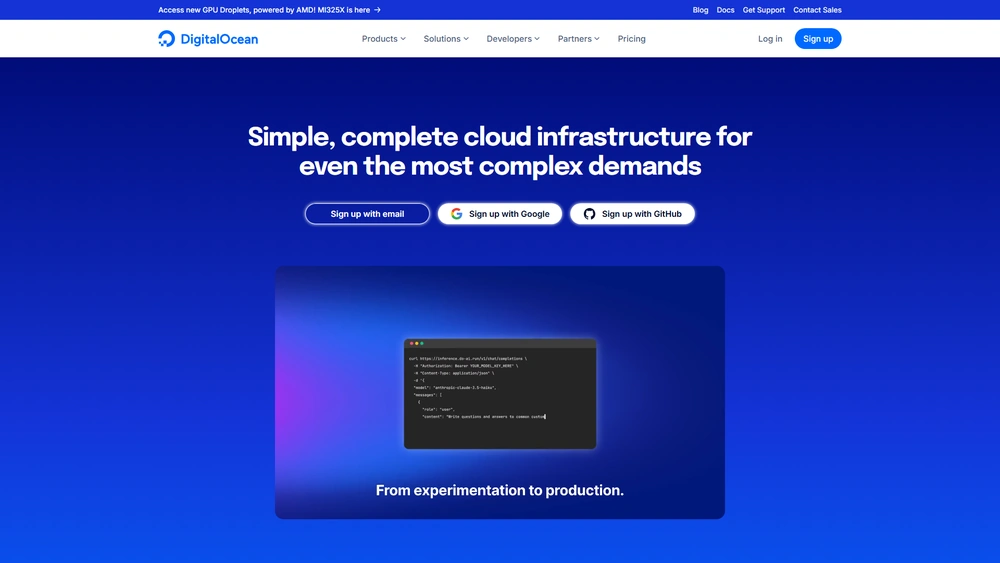DigitalOcean Overview & 2025 Industry Position
DigitalOcean has positioned itself as a developer-first, cloud infrastructure provider catering to startups, dev teams, and SMBs. While AWS and Azure dominate the enterprise scene, DigitalOcean thrives with simplicity, transparent pricing, and performance-focused services. In 2025, it’s carving out a deeper niche delivering AI-ready compute, Kubernetes orchestration, and highly performant databases—minus the enterprise overhead.
Trusted by over 600,000 customers, including growing SaaS companies and indie developers, DigitalOcean continues to offer a cloud environment tailored for speed, ease, and value. With increasing demand for AI integration in SaaS and agile development workflows, DigitalOcean is shaping the future of lean digital innovation.
From Launch to 2025: DigitalOcean’s Journey
Founded in 2011 in New York City, DigitalOcean originally disrupted the IaaS space by offering $5 droplets—cloud servers that launched in 55 seconds. It targeted developers frustrated by complexity in larger cloud ecosystems.
- 2012: Public beta for SSD cloud servers.
- 2013: Hits 100,000 developers; launches one-click apps.
- 2015: Begins expanding data centers globally.
- 2018: Launches managed Kubernetes.
- 2021: IPOs on NYSE under ticker DOCN.
- 2024: Introduces GPU Droplets and managed MongoDB/Redis.
In 2025, DigitalOcean’s strategy emphasizes affordable AI workflows, frictionless scaling for SaaS, and a developer-first ecosystem supporting startups at every stage.

DigitalOcean Key Features
DigitalOcean’s current product stack has grown impressively beyond just droplets. Key components include:
- Droplets: Virtual machines optimized for performance, now including GPU Droplets for ML/AI workloads.
- Kubernetes: Fully managed clusters with low overhead auto-scaling and monitoring.
- Managed Databases: PostgreSQL, MySQL, Redis, and MongoDB with failover, backups, and scaling options.
- App Platform: A PaaS experience allowing code deployment from GitHub with zero infrastructure worries.
- Spaces & Volumes: Scalable object and block storage solutions integrated into the ecosystem.
- Marketplace: One-click apps including CI/CD tools, CMSs, and monitoring solutions like Docker and Jenkins.
Its combination of PaaS functionality, infrastructure flexibility, and clear pricing make it a strong asset for growing teams needing predictable costs and high uptime.
Workflow & UX
DigitalOcean’s hallmark continues to be its sleek, minimalist dashboard designed with developers in mind. Setup flows are clean, and most services launch within minutes. Key highlights:
- Global search and resource tagging for multi-project visibility.
- Project-based resource grouping helps manage teams and apps efficiently.
- Integrated metrics, alerts, backups, and snapshots built in without extra tooling.
- Clear billing reports with usage breakdown and forecasts.
Pro Tip: Use DigitalOcean projects to isolate apps or staging environments—they simplify billing and permissions immensely.
DigitalOcean Pricing Analysis & Value Metrics
Transparent pricing remains a driving force for DigitalOcean’s SMB loyalty. As of July 2025:
| Product | Starting Price | Includes | Ideal Use |
|---|---|---|---|
| Basic Droplets | $4/month | 1 vCPU, 512MB RAM, 500GB transfer | Simple web apps, Dev servers |
| Premium CPU/GPU | $28–$480/mo | Up to 16 vCPUs / GDX A100 options | AI apps, image processing |
| Kubernetes (DOKS) | $12/node | Auto-scaling, built-in metrics | Production-grade SaaS, APIs |
| App Platform | Free – $20+/mo | Build/deploy via GitHub, Auto SSL | Serverless apps, web services |
| Managed DBs | $15/mo | Automated backups, resizing | Data-heavy apps, analytics |
Value assessment: DigitalOcean wins on price simplicity and delivers consistent performance without surprise costs common in other clouds. Ideal for predictable budgets.
Competitive Landscape
Here’s how DigitalOcean stacks up against other cloud providers:
| Provider | Best For | Pricing | Strength | Weakness |
|---|---|---|---|---|
| AWS | Enterprises | Complex, metered | Scalability, integrations | Overhead, pricing opacity |
| Google Cloud | ML/AI Devs | Flexible, credits for startups | AI services, data tools | Steep learning curve |
| DigitalOcean users | Startups, Dev SMEs | Simple, fixed tiers | Developer UX, fast scaling | Limited compliance features |
Top Use Cases
Where DigitalOcean excels in 2025:
- SaaS Platforms — turnkey backend with scalable DB and App Platform
- AI/Machine Learning Models — using GPU Droplets
- Developer Staging — low-cost environments for branches or forked deploys
- Tech Startups — predictable growth path from MVP to production
- API Integrators — leveraging DOKS and load balancers for container-based apps
DigitalOcean Integrations
DigitalOcean connects well with developer tools, CI systems, and app ecosystems:
- GitHub/GitLab: Auto-deploy with App Platform
- Terraform/Ansible: Full infrastructure-as-code support
- Stripe/Shopify: Host backend microservices for apps on external platforms
- Slack, PagerDuty: Alerts and ops signals integration
Pros & Cons
- Pros:
- Affordable, transparent pricing
- Developer-centric UX
- Fast deploy/performance
- No startup over-complexity
- Cons:
- No Windows instances by default
- Limited compliance (HIPAA, FedRAMP)
- Advanced networking setup can require CLI
Final Thoughts
DigitalOcean remains a perfect match for bootstrapped startups, indie developers, and scaling SaaS companies requiring simplicity, performance, and control. Customers needing extreme compliance or hyper-enterprise integrations may still turn to AWS or Azure, but DigitalOcean uniquely succeeds in being purpose-built for smart scaling teams in 2025.
DigitalOcean FAQ
Yes. With its clean dashboard, 1-click apps, and vibrant tutorials, DigitalOcean is often recommended for cloud beginners and junior developers.
Yes, DigitalOcean launched GPU droplets in 2024 with NVIDIA A100 options for machine learning, video rendering, and GPU-heavy tasks.
Absolutely. Use their App Platform to deploy front-end and back-end code directly from GitHub with SSL, CDN, and auto-scaling included.
Yes, their managed Kubernetes solution (DOKS) simplifies orchestration with autoscaling, load balancing, and built-in monitoring tools.
In most SMB scenarios, yes. With flat-rate pricing and no hidden bandwidth costs, many developers find DigitalOcean up to 60% cheaper.
